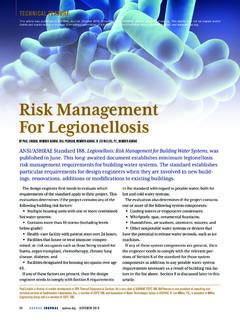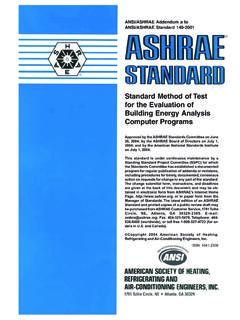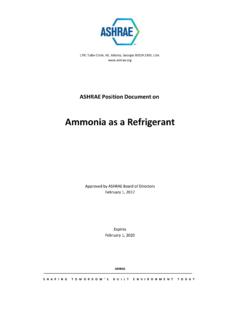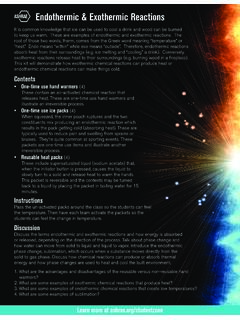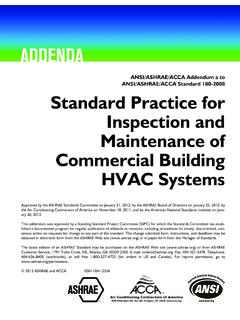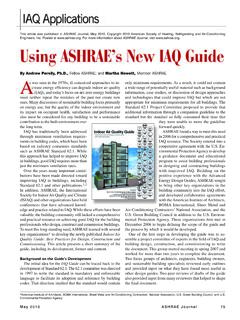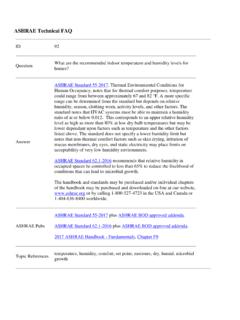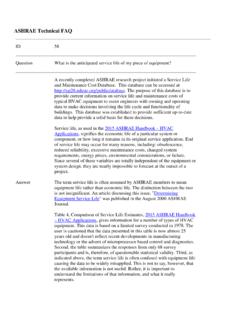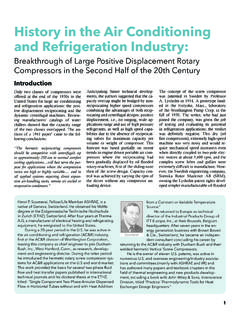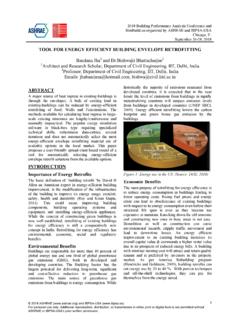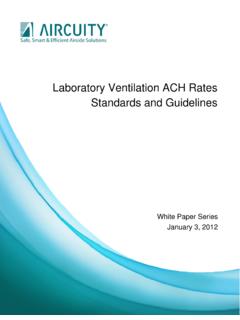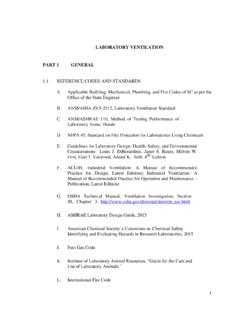Transcription of Classification of Laboratory Design Levels - ashrae.org
1 Classification ofLaboratoryVentilationDesign LevelsDeveloped byASHRAE Technical Committee , Laboratory SystemsLaboratory Classification SubcommitteeIn partnership withAmerican Chemical SocietyDivision of Chemical Health and SafetyandAmerican Industrial Hygiene AssociationLaboratory Health and Safety CommitteeAtlantaThis publication was developed by the Laboratory Classification Subcommittee ofASHRAE Technical Committee (TC) , Laboratory Systems, with support frommembers of other organizations that specialize in Laboratory health and TC Laboratory Classification SubcommitteeAdam Bare, PE, ChairNewcomb & Boyd, LLPR oland Charneux, PE, HFDP, ashrae FellowPageau & MorelJim CooganSiemensGary Goodson, PEExposure Control Technologies, HaysUSDA Agricultural Research ServiceNathan Ho, PEP2S Engineering, PerreaultEvap-Tech MTC SmithExposure Control Technologies, from Other OrganizationsDebbie DeckerUniversity of California, DavisKen KretchmanNorth Carolina State UniversityRebecca Lally, CIHS outhern California EdisonElizabeth Kolacki, PECornell UniversityPeter SlinnNatural Resources CanadaRalph Stuart.
2 CIHK eene State CollegeEllen SweetCornell UniversityThis work is the product of an effort started by Andrew Dymek well over 10 years to everyone involved for their help in producing this thanks go to Tom Smith for his considerable for this publicationwill be posted on the ashrae website 978-1-939200-90-7 (PDF) 2018 ASHRAE1791 Tullie Circle, NEAtlanta, GA rights is a registered trademark in the Patent and Trademark Office, owned by the American Society of Heat-ing, Refrigerating and Air-Conditioning Engineers, has compiled this publication with care, but ashrae has not investigated, and ashrae expressly dis-claims any duty to investigate, any product, service, process, procedure, Design , or the like that may be describedherein. The appearance of any technical data or editorial material in this publication does not constitute endorsement,warranty, or guaranty by ashrae of any product, service, process, procedure, Design , or the like.
3 ashrae does notwarrant that the information in the publication is free of errors, and ashrae does not necessarily agree with anystatement or opinion in this publication. The entire risk of the use of any information in this publication is assumed bythe part of this publication may be reproduced without permission in writing from ashrae , except by a reviewerwho may quote brief passages or reproduce illustrations in a review with appropriate credit, nor may any part of thispublication be reproduced, stored in a retrieval system, or transmitted in any way or by any means electronic, pho-tocopying, recording, or other without permission in writing from ashrae . Requests for permission should besubmitted at of Congress Cataloging in Publication Control Number: 2018011558 ashrae STAFFSPECIALPUBLICATIONSMark S.
4 Owen,Editor/Group Manager of Handbook and Special PublicationsCindy Sheffield Michaels,Managing EditorJames Madison Walker,Managing Editor of StandardsLauren Ramsdell, Assistant EditorMary Bolton,Editorial AssistantMichshell Phillips,Editorial CoordinatorPUBLISHINGSERVICESD avid Soltis,Group Manager of Publishing ServicesJayne Jackson,Publication Traffic AdministratorPUBLISHERW. Stephen and Work by Other and for Control of Airborne and Features ofLaboratory Airflow Control Ventilation Design Criteria and Attributes forLaboratory Ventilation Design of Laboratory Ventilation Design Levels1 IntroductionThe Laboratory Classification Subcommittee of ashrae Technical Commit-tee (TC) , the Laboratory Health and Safety Committee of the AmericanIndustrial Hygiene Association (AIHA), and the Division of Chemical Health andSafety of the American Chemical Society (ACS) have partnered to provide thisdocument to help facility professionals Design and operate laboratories with thecapability of supporting the management of exposures to airborne chemicals gen-erated during Laboratory scale activities.
5 It is important to note that ventilationalone cannot handle all Laboratory chemical hazards and that this documentassumes other control measures, including minimization of chemical risks, goodlaboratory housekeeping, and appropriate emergency procedures, are also inplace. There is a hierarchy of controls that is well established in the safety profes-sion. Laboratory ventilation is a form of engineering controls, which is one layerin this hierarchy. (See the National Institute for Occupational Safety and Health[NIOSH] website for moreinformation on the hierarchy of controls [NIOSH 2016].)For the purposes of this document,laboratoryscaleis defined as a workplacewhere hazardous chemicals are used on a nonproduction basis. The OccupationalSafety and Health Administration (OSHA) Laboratory standard 29 (b) states:Laboratoryscalemeans work with substances in which the con-tainers used for reactions, transfers, and other handling of sub-stances are designed to be easily and safely manipulated by oneperson.
6 Laboratory scale excludes those workplaces whosefunction is to produce commercial quantities of materials. (OSHACFR )While this definition does not place limits on the types or severity of chemicalhazards used in laboratories, it does limit the quantity of materials potentiallyreleased into the Laboratory environment to about 4 L (1 gal) or less per the risk of exposure to Laboratory scale generation of airborne chemicalhazards means controlling airborne concentrations below Levels known or sus-pected to cause harm to people, property, or the environment through a combina-tion of general and local ventilation as well as the other measures risk of exposure to unsafe concentrations of airborne chemicals in labora-tories can range from negligible to extreme, depending on the activities conductedin the laboratories, the types of hazardous chemicals, the quantities of materials,the characteristics of generation, the duration of exposure, and the protection 2018 ashrae ( ).
7 For personal use only. Additional reproduction, distribution, or transmission in either print or digital form is not permitted without ashrae 's prior written of Laboratory Ventilation Design Levelsafforded by the Laboratory airflow and airborne contaminant control systems. Forthis reason, a risk assessment must be conducted based on the best available infor-mation about the chemical work to be conducted in the Laboratory . The ability tomitigatetherisk to people, property, and the environment depends on providingan adequate level of protection through proper Design , operation, and utilization ofthe Laboratory ; the exposure control devices (ECDs), such as fume hoods; and thelaboratory ventilation systems. Collectively, the ECDs, the exhaust systems, theair supply systems, and the elements of the Laboratory that may affect airflow andcontrol of airborne contaminants are referred to herein as thelaboratory airflowcontrol system(LACS).
8 The purpose of the LACS is twofold: it must (1) help pre-vent overexposure to airborne chemical hazards generated during Laboratory scaleactivitiesand(2) satisfy the temperature and humidity conditioning requirementsof the occupants and the processes they conduct in the Laboratory protective capability afforded by an LACS must be commensurate withthelevelof risk associated with the airborne chemical hazards that may be gener-ated. Tables 2 and 3 provide physical Design attributes and operating specifica-tions for an LACS divided into five Laboratory ventilation Design Levels (LVDLs)rangingfromLVDL-0 to LVDL-4. The attributes and specifications for eachLVDL are intended to provide increasing Levels of protection and control of air-borne chemical hazards to minimize the risk of overexposure.
9 Specifically, anLACS withattributes and specifications associated with LVDL-0 offers the lowestlevel of protection for working with hazardous airborne chemicals, while anLACS designed and operated according to LVDL-4 recommendations offers thehighest level and control of airborne hazards. It is important to note that this guidedoes not provide the tools needed to assess the risk associated with laboratoryscale use of hazardous chemicals. The information contained herein can be usedto evaluate the protective capability of an existing LACS or to help Design andoperate an LACS according to the anticipated level of risk or the degree of protec-tion considered necessary to provide a safe and healthy Laboratory may increase the protective capability of the Laboratory , theywill also increase the costs of construction, result in greater energy consumption,increase operating costs, and increase the level of effort required to manage andmaintain performance.
10 These considerations must be carefully considered in thedesign and operation of Laboratory safety is an inviolable constraint and must not be sacrificed forgainsinproductivity or operating efficiency. Protective measures must be avail-able and appropriate to provide adequate protection and can include a combina-tion of administrative controls, personal protection, and engineering controls. 2018 ashrae ( ). For personal use only. Additional reproduction, distribution, or transmission in either print or digital form is not permitted without ashrae 's prior written of Laboratory Ventilation Design Levels3 Purpose and ScopeThis effort is limited to issues related to Design and operation of laboratoriesand their interactions with LACSs that provide conditioning and control of envi-ronmental air quality in laboratories.
